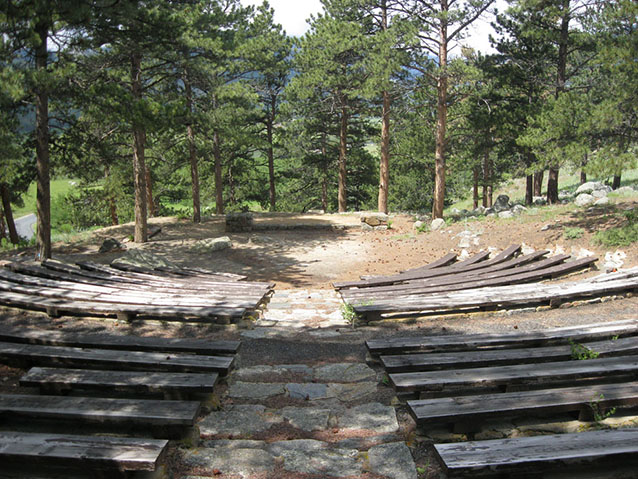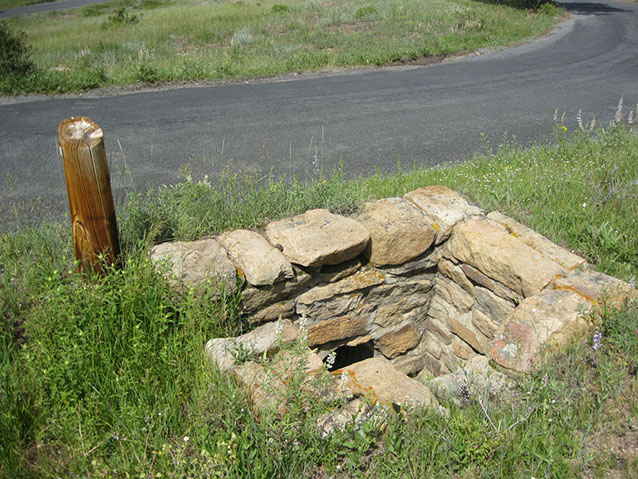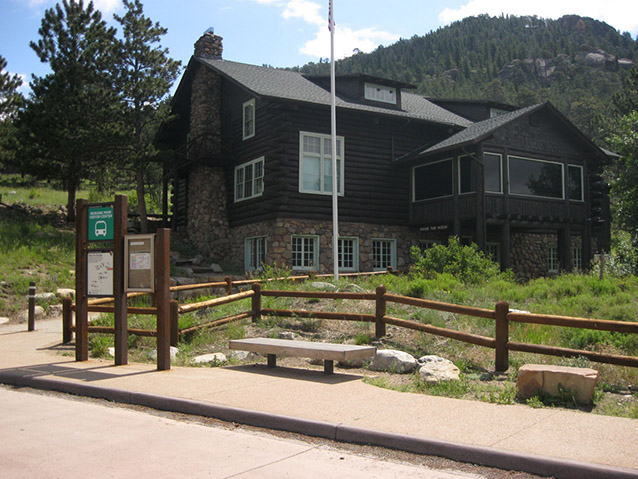The Moraine Park Museum and Amphitheater sits in the northeast corner of Moraine Park, within Rocky Mountain National Park and at the base of Eagle Cliff Mountain. The landscape can be accessed from Bear Lake Road, a little over one mile from the Rocky Mountain National Park Administration Building on US Highway 36. At an elevation of roughly 8100 feet, it offers views to the west of Moraine Park and to the Big Thompson River.
Moraine Park Museum and Amphitheater is an important example of the growth of the local resort and tourism industry, of conservation efforts of Depression-era work programs and the National Park Service, and of naturalistic design.

NPS / C. Mardorf
The setting is dominated by views of Longs Peak. Important built features include the Moraine Park Museum; the amphitheater, including plank and stone seating, drainage structures, the foundation of the screen, and fire pit; pedestrian circulation system, including stone steps and trails; and the entry road and parking lot, including stone culverts.
Notable natural features include the curtain wall of pines surrounding the stage area; the ponderosa pine tree marking the intersection of the entry trails; the ponderosa pine tree within the seating area of the amphitheater; and the views of the valley and Longs Peak. The landscape is characterized by its native upland shrub vegetation.
Beginning in the 1870s, Moraine Park cast a spell over visiting tourists, many of whom remained and homesteaded its quiet meadows. One of these tourist-turned-landowners was Imogene Greene MacPherson. Between 1905 and 1923, she built the Moraine Lodge, a collection of rustic buildings to introduce guests to the Rocky Mountain experience. After her death in 1928 and with the Great Depression of the 1930s, the number of guests declined rapidly. In 1931, the National Park Service bought the property from the MacPherson estate, quickly altering the property from a rustic resort to a modern visitor facility.

NPS / C. Mardorf
The National Park Service alterations reflect an important period of conservation philosophy with design changes that focused on preserving the "wildness" of National Parks. This included naturalizing developed areas, building visitor facilities with "naturalistic" design, and communicating a strong natural ethic to visitors. To accomplish these goals in the 1930s, the Civilian Conservation Corps (CCC) obliterated most of the Moraine Lodge, restoring the land to its "natural" state.
By 1936, the CCC converted the Moraine Lodge's Assembly Hall to a National Park Service museum, and they began to construct an amphitheater nearby. This amphitheater design followed naturalistic principles, utilizing native plants and materials and responding to the natural bowl-shaped topography to construct a structure connected to its landscape.
The strong association between the amphitheater and the newly converted museum reflected the National Park Service's evolving education and interpretation programs, which focused on formal presentations with cutting edge technology of lantern slides. The amphitheater is currently used for weddings and K-12 education programs.

NPS / C. Mardorf
The amphitheater's naturalistic design reflected the conservation efforts of the National Park Service during the 1930s when hand labor was readily available from the CCC. The basic tenets of this NPS Rustic design was that architecture played a subordinate role to nature, the structures responded to the terrain, and the design blended into the natural setting.
The use of native material available in the vicinity of the site was encouraged, making stone and timber the materials of choice for most parks, including Rocky Mountain National Park. The National Park Service applied this naturalistic or Rustic design to buildings, by blending materials with their natural surroundings and reflecting hand-tool construction. The Moraine Park site represents one of the earliest, fully realized examples of this type of amphitheater design in the National Park Service. The Moraine Park Amphitheater's naturalistic design utilized the natural bowl site, retained and enhanced native plantings, used rustic materials such as wood and stone, included the fire circle, and focused the view across Moraine Park.
Quick Facts
- Cultural Landscape Type: Designed
- National Register Significance Level: National
- National Register Significance Criteria: A, C
- Period of Significance: 1923-1955
Landscape Links
Last updated: January 15, 2020
